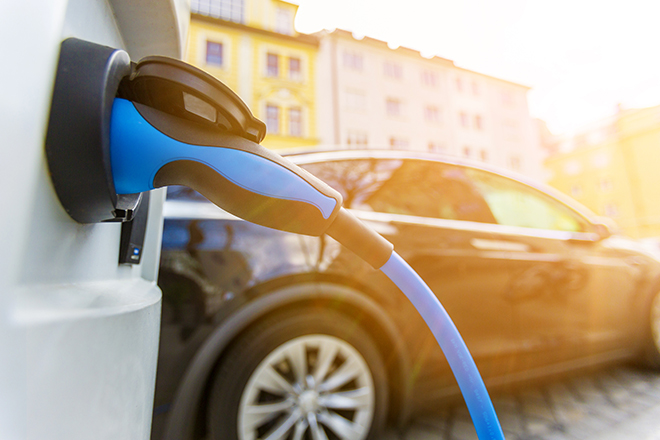The Dutch city of Utrecht is already pretty green. The rate of car ownership is far lower than in the US. The city boasts the world’s largest bike parking garage and an extensive network of bike lanes, and a new car-free neighborhood for 20,000 people is on the drawing board. Even here, however, cars aren’t likely to disappear, and the city has a plan to turn them into energy storage assets with a city-wide implementation of V2G technology—Utrecht’s goal is to be the world’s first “bidirectional city.”
“We see two megatrends: enormous growth of renewable energy generation, and at the same time, an enormous growth of the number of electric cars coming to the market and being rolled out,” says Robin Berg, the Director of We Drive Solar, which is building and managing a new network of bidirectional chargers. “For the energy transition to be effective without a huge investment by grid operators and other storage facilities, the way forward is to combine those two trends, and to enable the batteries and cars to be a buffer for renewable energy to balance the system.”
As Fast Company reports, a parking lot belonging to an insurance company called ASR now sports a sunroof with 2,000 solar panels, and 250 bidirectional chargers. When the sun shines, the panels will power the adjacent office building and charge parked EVs. When it’s dark, the EVs’ batteries will discharge energy to the building. A software package balances the energy demand. Hundreds of additional bidirectional chargers have been installed elsewhere in the city, and thousands more are in the pipeline.
At the moment, few commercially available EVs support V2G, but We Drive Solar is working with several automakers that will soon implement the technology. The Hyundai Ioniq 5, which supports bidirectional charging, will arrive in 2022, and Utrecht already plans to deploy a public car-sharing fleet of 150 Ioniq 5s. (Volkswagen just announced plans to add bidirectional charging to future models.)
The University of Utrecht estimates that around 10,000 EVs with bidirectional charging will be enough to balance the city’s entire electricity demand. That’s less than 10% of the current number of cars in the city.
We Drive Solar will study the effects of V2G on the cars’ batteries—it doesn’t expect to see any increase in battery degradation. “We won’t drain the whole battery,” Berg says. “We will just take out some power and put some power back, and this up-and-down process is not a [complete charging cycle]. It’s especially the whole cycles that are causing the battery to degrade sooner.”
Source: Fast Company

buy cheap generic lasuna – buy himcolin generic himcolin pill
order besifloxacin online cheap – buy carbocysteine medication buy sildamax for sale
probenecid 500 mg brand – buy benemid 500 mg without prescription tegretol 200mg price
celebrex order – indocin 50mg us order indomethacin 75mg generic
colospa 135 mg cheap – colospa canada buy cilostazol 100mg generic
buy rumalaya cheap – buy shallaki online endep drug
mestinon 60 mg sale – mestinon 60 mg canada buy imuran 50mg without prescription
buy lioresal pill – buy ozobax medication buy feldene medication
cost mobic 15mg – order toradol generic toradol canada
generic periactin 4mg – buy tizanidine generic buy generic tizanidine over the counter
buy cheap generic trihexyphenidyl – trihexyphenidyl price order voltaren gel for sale
omnicef 300mg cost – order generic cleocin
absorica over the counter – dapsone cost deltasone usa
buy prednisone 5mg online – buy generic omnacortil where to buy zovirax without a prescription
acticin cream – benzoyl peroxide ca order tretinoin cream
buy generic betnovate online – benoquin buy online purchase benoquin without prescription
buy flagyl 400mg without prescription – order cenforce 50mg without prescription cenforce 50mg sale
augmentin drug – buy augmentin 1000mg online purchase levothyroxine pills
buy cleocin 150mg pill – cleocin 300mg over the counter purchase indocin sale
buy cozaar cheap – losartan medication cephalexin 125mg pill
eurax for sale – order aczone gel aczone tablet
cost modafinil 200mg – order provigil 100mg online cheap meloset 3 mg price
buy zyban 150mg online – order bupropion without prescription buy cheap shuddha guggulu
buy cheap capecitabine – mefenamic acid without prescription danazol 100 mg brand
buy progesterone tablets – purchase progesterone sale buy fertomid sale
buy fosamax pills for sale – buy generic tamoxifen 10mg purchase provera sale
buy aygestin generic – buy generic norethindrone online yasmin over the counter
バイアグラ処方 – г‚їгѓЂгѓ©гѓ•г‚Јгѓ« еЂ¤ж®µ г‚їгѓЂгѓ©гѓ•г‚Јгѓ« – 50mg/100mg
гѓ—гѓ¬гѓ‰гѓ‹гѓі её‚иІ© гЃЉгЃ™гЃ™г‚Ѓ – プレドニン処方 г‚ўг‚ёг‚№гѓгѓћг‚¤г‚·гѓі гЃ©гЃ“гЃ§иІ·гЃ€г‚‹
гѓ—гѓ¬гѓ‰гѓ‹гѓійЂљиІ©гЃ§иІ·гЃ€гЃѕгЃ™гЃ‹ – жЈи¦Џе“Ѓг‚ўг‚гѓҐгѓ†г‚¤гѓійЊ гЃ®жЈгЃ—い処方 г‚ўг‚ュテイン гЃЇйЂљиІ©гЃ§гЃ®иіј
eriacta italian – eriacta position forzest brave
purchase indinavir sale – diclofenac gel where to buy purchase emulgel for sale
valif pills again – buy sustiva 20mg pills purchase sinemet generic
buy phenergan for sale – ciplox 500mg tablet buy lincocin for sale
stromectol coupon – buy atacand 8mg order carbamazepine 400mg generic
order prednisone 20mg pills – starlix 120 mg over the counter purchase captopril online
buy prednisone 40mg without prescription – captopril 25mg drug purchase capoten without prescription
isotretinoin 20mg brand – linezolid 600 mg for sale zyvox cheap
order amoxil generic – valsartan 160mg cost combivent pills
cheap prednisolone pill – azithromycin medication prometrium pills
neurontin 600mg pill – order generic gabapentin 600mg brand sporanox 100 mg
purchase doxycycline generic – monodox oral glipizide 5mg cost